Gettysburg, Reborn: Spring on the Battlefield
The peepers surrounding Spangler’s Spring are beautifully deafening. A sea of cream-and-gold daffodils blankets the gentle slopes of Oak Ridge. The vibrant purple redbud in Rose Woods intermingles with delicate white dogwood before a lush backdrop of verdant leaves and light green shrubbery. Spring has returned to the battlefield.
The cheerful chirp and whistle of birds carries in the gentle, warm breezes that swirl around Barlow’s Knoll as robins and finches busily dart from tree to tree, attending to the new life occupying their nests. The red-winged blackbirds squawk and flutter defensively between the two craggy walls bounding the Railroad Cut, vociferously chiding even drive-by “intruders,” as they seek to reclaim their seasonal turf in the grasses stretching before Seminary Ridge. A bluebird peeps out from a lofty pine overlooking the site of the violent clash between Archer’s Confederates and the famed Iron Brigade along the Harmon Farm, quietly surveying the delicate, lacy daisies bowing softly in the wind. Spring has returned to the battlefield.
The once brown, shorn, empty meadows before McPherson’s Ridge have been renewed by the kiss of spring rains. A family of cows grazes peacefully once more on the now thick and waving grass, blissfully, innocently—thankfully—unaware of the human bloodbath that once soaked and stained those grasses. Freshly tilled and planted fields give way to rolling meadows of resplendent yellow that stretch forth alongside the Chambersburg Pike; the undulating spine of South Mountain glows light green and tan under the warm sun, the occasional passing cloud casting dramatic shadows along its slopes. The watchful eye of General Reynolds astride his stone steed sees it all. Spring has returned to the battlefield.
The cool spring waters of Willoughby Run rush, trickle, and gurgle in alternating rhythm while purple-green violets stand listening, waiting along the muddy banks. Bountiful soft pink blossoms explode from the crooked limbs of Sherfy’s Peach Orchard, transforming skeletal frames into works of art. The air is sweet with the scent of new flora and moist grass. The quiet, peaceful chirp of crickets soothes and comforts. The gentle pawing and whinny of a grazing horse is just barely audible from the pastures of the distant Rose Farm. A beautiful chestnut mane blows wistfully in the breeze within the pasture, while a curious, deep-onyx head bearing a striking white star quietly peers over the boulder-ridden ground and split rocks toward the tour road; a car slows to a halt as a Licensed Battlefield Guide points out the window to where scores of bloated Confederate dead were once laid out in neat lines for burial between those iconic split rocks, their forms immortalized on camera by Alexander Gardiner. Spring has returned to the battlefield.
Sight lines and trails laid bare by winter’s frozen touch begin to fade away under new growth, obscuring seldom-visited monuments and drawing green curtains over the terrain, as if with a knowing smile; only the most hardened and determined of battlefield-tromping tourists will now know the secrets the soldiers once knew of the landscape—secrets exposed to the “windshield tourist” just temporarily, as if a seasonal gift, with the falling of the leaves, the clearing of the fields, the bite of the frost. Yet it is only in trekking through the thick green woods of Culp’s Hill or Herbst Woods, only in climbing the steep, tree-lined slopes of Big and Little Round Tops, only in wading through the dense undergrowth of the Wheatfield that we might truly understand the land as the soldiers knew it that July. And so spring has returned to the battlefield.
The sinister boulders of Devil’s Den resound once more with the innocent echo of exploring children. The metal observation towers, formerly gated off out of social distancing concerns and too-long barren of visitors, once more rattle with the footsteps of eager tourists and battlefield guides whose silhouettes bring familiar comfort to the bright blue skyline. A mass of observers gathers in the balcony atop the newly reopened Pennsylvania Memorial, pointing, posing for photos, even picnicking under the warm sun. The gentle clip-clop of hooves on wet soil and the soft snorting of horses echoes from the wood line behind the Virginia Memorial as a long line of tourists on horseback emerges from the leafy curtain and gazes upon the formidably beautiful visage of Cemetery Ridge before them. The silhouettes of cannon—in some places, just small pockets, in other places, long lines—dot the ridges, the sheen of the sun-kissed bronzed tubes blinding, but grand. Small groups of families and Scouts speckle the fields between Seminary Ridge and the Angle as they slowly traverse “Pickett’s Charge,” in Kemper’s footsteps, or Garnett’s, or Armistead’s. Spring has returned to the battlefield.
The majestic red siding of the Codori barn stands stoically beside the Emmitsburg Road; park rangers, battlefield guides, staff ride leaders, and teachers gesture dramatically in its direction with sweeping movements that direct the eye up toward the Angle. The spindly cluster comprising the famed Copse of Trees is quickly regaining its distinctive summer shape by which millions have come to reference it. A long line of enormous tour buses slowly snakes its way along the ridges and through the swales of green. Cars pockmark the roads at every turn, and parking lots overflow with visitors. It has been too long. Spring has returned to the battlefield.
The stone sentinel of the 24th Michigan continues to prime his musket for eternal battle in Herbst Woods as he stares into the now thickening green foliage that has come to nearly obscure Willoughby Run and the advance route of Pettigrew’s North Carolinians. Louisiana’s “Spirit of the Confederacy” dances midair in renewed springtime jubilation along Seminary Ridge, the sun glinting brightly off her flaming cannonball. The 1st Minnesota sentinel, with foot uplifted and bayonet affixed against the turquoise sky, appears more anxious than ever to make his dash toward Plum Run and stem the tide of Wilcox’s Alabamians. The mammoth-sized, prone Tarheels atop the North Carolina Memorial lurch ever more forward toward Cemetery Ridge, their eyes seemingly wider, their fingers seemingly more pointed, their flags almost seeming to quiver in the breeze. Spring has returned to the battlefield.
This pristine spring landscape and the rebirth of life—human, floral, faunal—is deceptively, yet poignantly beautiful. It sanitizes the horror, masks the suffering, and makes the destruction nearly unfathomable. Intentions, causes, and conflict become strangely—fleetingly—invisible from this conflict-torn land. It is a seductive feeling. Yet, the mind knows better than to lose itself entirely to these fancies and becomes once more drawn back to earth, spewing questions and craving answers of this contested, gore-soaked ground. It begs the spring to unshroud, to uncloak, to unmask the horrors and the suffering and the destruction—the intentions, the causes, the conflict . . . the legacies . . . even as the heart dances joyfully in the beauty, longing for more. There has been too much suffering this past year, and yet it is here, in this season, that suffering might best be understood—might find new meaning, new purpose. There is conflict between the heart and the mind, longing for peace, beauty, rejuvenation . . . for uncomfortable knowledge, unsettling answers, contested meanings. And so spring has returned to the battlefield.
Sunset comes gloriously late and slow to Gettysburg this time of year, allowing for quiet evening strolls and contemplation. Soon the cicadas will return, contributing their own familiar cacophony to the summer’s nighttime symphony. The hauntingly beautiful twenty-four notes of “Taps” will once more fill the air nightly from Gettysburg National Cemetery, fanning out over the graves of the fallen and the ground on which they fell, in solemn tribute to those “who here gave the last full measure of devotion.” The shadows grow long before Soldiers National Monument; History listens attentively, patiently, to War who gestures toward the distant killing fields while silently recounting the story of the battle to History’s poised stylus and tablet. Peace and Plenty glow orange in the setting sunlight, but it is Lady Liberty who shines resplendently, triumphantly atop her tall white pillar in celebration of the nation’s “new birth of freedom” secured by the thousands lying beneath the solemn white semicircles of stone surrounding her…and the hundreds of thousands of their comrades at eternal rest across the nation. But this year, this season, Lady Liberty’s halo seems strikingly brighter; Gettysburg has been reborn. The nation has been reborn. Hope, health, happiness have finally re-sprouted; it has been a brutal year-long winter of discontent—a seemingly eternal winter that has bitten, killed, destroyed with ruthless impunity, has frozen hearts and spirits and souls. But now, finally, comes the thaw. New birth…re-birth. Spring has returned to the battlefield.
Romancing young couples, solemn military veterans, scholars, buffs, and local residents alike gather fearlessly close, once more, atop the summit of Little Round Top in quiet reverence as the brilliant reds, oranges, and caramel yellows paint the enormous canvas of sky. Beside them, a dutiful Gouverneur Warren, with field glasses firmly in hand, silently maintains his eternal observation of the fields and borough below. The innocent giggle of children playing amid the boulders echoes across the Valley of Death beneath. Slowly, gloriously, the sunlight bathes the farm fields and ridges in one more dramatic splash of grandeur before settling in behind the hills and mountains. The distinctive slanted frames of the Pennsylvania bank barns, the rough-hewn stone farmhouses, the long worm fences snaking across the rolling fields, the glinting metal barrels of cannon, the sentinels of stone and bronze, the crooked stone walls and intermittent boulder fields bordering the greening orchards become dark; the Eternal Peace Light flickers and beckons quietly in the distance. They’ve seen it all before, but this year, it’s somehow different. Spring has returned to the battlefield. Life has returned to the battlefield.
*All photographs taken by the author


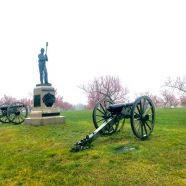





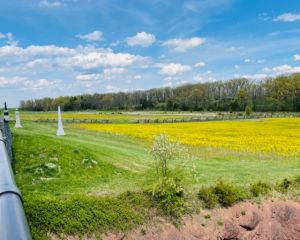

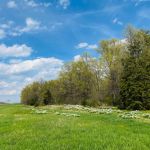

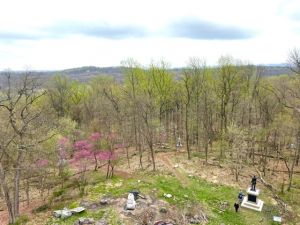
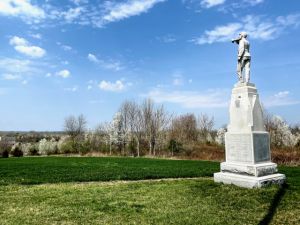
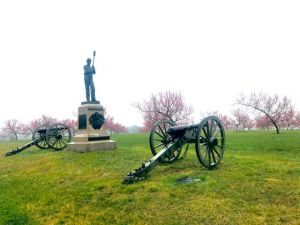
Very, very beautiful, Ashley. I was transported to the battlefield. So well done. I am in awe.
Very beautiful, Ashley. When I visited the battlefield, I was horrified to imagine so many tens of thousands of soldiers levying modern warfare against each other, and our great-great grandfather so badly wounded on the first day lying there in pain for God knows how long.